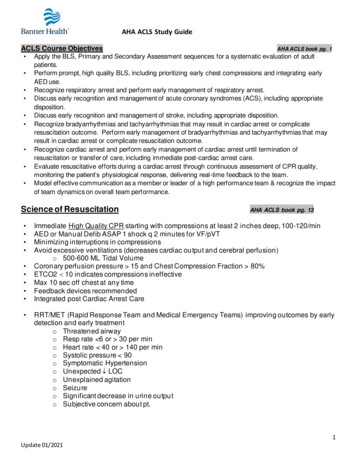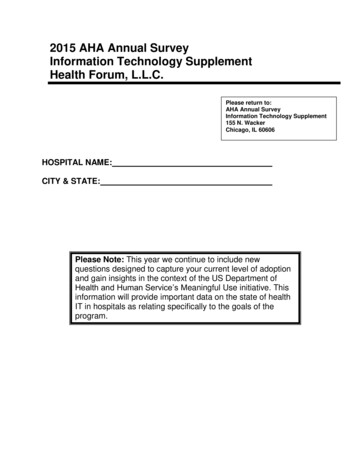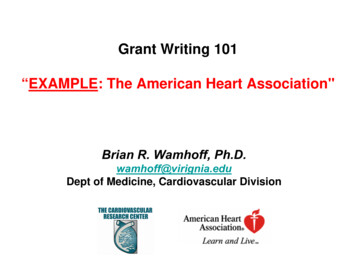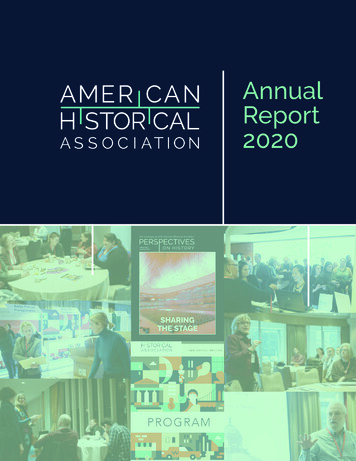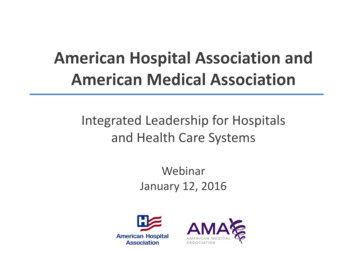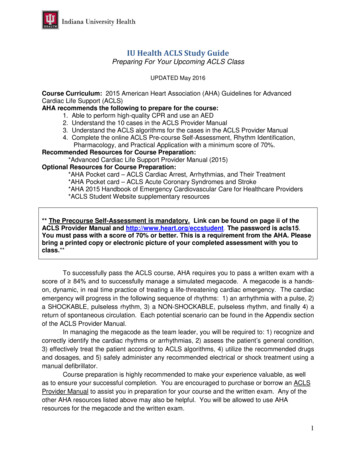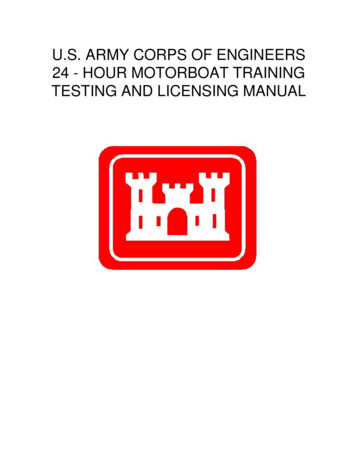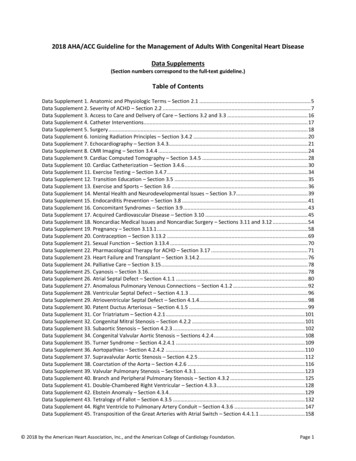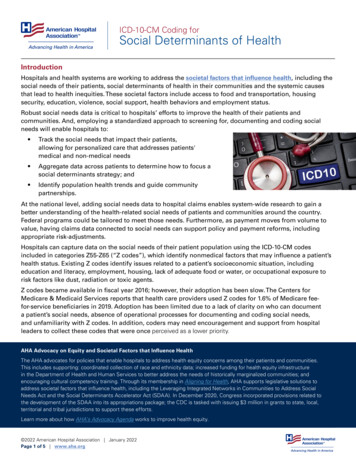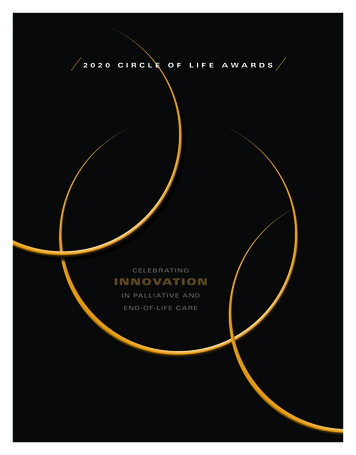
Transcription
2020CIRCLEOFLIFECELEBRATINGINNOVATIONIN PALLIATIVE ANDEND-OF-LIFE CAREAWARDS
ABOUT THE AWARD2019–2020 CIRCLE OF LIFE COMMITTEEMajor sponsors of the 2020 Circle of Life AwardsCHAIRare the American Hospital Association, the Cath-Martha L. Twaddle, MD, FACP, FAAHPM, HMDCNorthwestern Medicine - Lake Forest Hospital Lake Forest, Ill.olic Health Association, and the National Hospiceand Palliative Care Organization and National Hos-MEMBERSpice Foundation. The 2020 awards are also fund-Cathleen BennettNew Jersey Hospital Association Princeton, N.J.ed, in part, by the Cambia Health Foundation. Theawards are cosponsored by the American Acade-Lori Bishop, MHA, BSN, RNNational Hospice and Palliative Care Organization Alexandria, Va.my of Hospice and Palliative Medicine, the CenterJames A. Block, MDJ.A. Block Health Associates and Center to Advance Palliative Care Towson, Md.to Advance Palliative Care, the Hospice & PalliativeNurses Association/the Hospice & Palliative Credentialing Center/the Hospice & Palliative NursesKaren Bullock, PhD, LCSWNorth Carolina State University Raleigh, N.C.Foundation, and the National Association of SocialRobert F. CasalouTrinity Health Michigan Canton, Mich.Workers. The Circle of Life Award is administeredby the Health Research & Educational Trust.Constance Dahlin, MSN, ANP-BC, ACHPN, FPCN, FAANHospice & Palliative Nurses Association Beverly, Mass.SENIOR EDITOR: Suzanna HoppszallernDeirdre Downes, LCSWIsabella Geriatric Center New York CityWRITER: Lola ButcherSteve FraneyFraney & Associates Portland, Ore.COPY EDITOR: Susan Edge-GumbelDESIGNER: Chuck LazarDenise Hess, MDiv, BCC-PCHAC, LMFTSupportive Care Coalition Hillsboro, Ore.Kathleen KerrKerr Healthcare Analytics Mill Valley, Calif.Shirley Otis-Green, MSW, MA, ACSW, LCSW, OSW-CE, FNAP, FAOSWCollaborative Caring Toluca Lake, Calif.STAFFGail Lovinger GoldblattAmerican Hospital Association ChicagoJane JeffriesAmerican Hospital Association Chicago2
INTRODUCTIONIn health systems, community hospitals and independent nonprofit organizations, passionate leaders are transforming palliative and end-of-life care in America. Because of their work, better treatments and protocols are available forpatients during this challenging time of life. More patients and family members understand their options and how toaccess them, and more physicians are embracing palliative care and hospice options for their patients.This year’s Circle of Life Award honorees inspire health care stakeholders to recognize that good palliative and endof-life care are simply good care: knowing what patients want and honoring their wishes. These leaders demonstratethat patient care improves when end-of-life questions become routine questions, regardless of a person’s age orhealth status. They show how a single hospice can evolve to deliver a wide range of services and improve care for anentire health system. They prove that an independent nonprofit based in a small rural town can be a national leaderin palliative and hospice care innovation. And they show how communication — the right words at the right time andthe right programming in the electronic health record — can improve patient care.These innovative programs serve not only people with serious and life-limiting illness, but also their loved ones. Indoing so, they are strengthening their communities with new knowledge, educational opportunities for caregiversand direct services that provide comfort and compassion for their patients. Please read their stories to learn more andjoin in the Circle of Life celebration of innovative palliative and end-of-life care programs that: Serve people with serious and life-limiting illness, their families and their communities. Demonstrate effective, patient/family-centered, timely, safe, efficient and equitable palliative and end-of-life care. Use innovative approaches to meeting critical needs and serve as sustainable, replicable models. Pursue quality improvement. Address biomedical, psychosocial, spiritual and cultural needs throughout the disease trajectory. Use innovative approaches to reach traditionally underserved populations. Actively partner with other health care organizations, education and training programs, the community, providers of careand/or insurers. Use metrics that demonstrate significant impact and value for individuals, families and communities.More information about the Circle of Life Award, complete award criteria and previous recipients is available atwww.aha.org/circleoflife.3
AWARD WINNERCaring Circle of LakelandSt. Joseph, MichiganIn the past decade, Caring Circle of Lakeland has evolved from athey help us think about how we can engage more proactively to provide anonprofit hospice to a multifaceted organization that helps agingbetter end-of-life experience.”and seriously ill individuals navigate rough terrain through a widerange of services. Before 2012, the organization focused solely onIn his view, the fact that Caring Circle is a wholly owned subsidiary of thecaring for people in their last six months of life, says Jason Beckrow,health system is essential to improving patient care. “If this were just aDO, medical director of hospice and palliative medicine. “Our goal nowcollaborative partnership, would we actually bring them inside to thoseis not six months — it’s the last six years of life,” he says. “How can wecore meetings where decisions are made — or would they be seen morehelp folks when they come to those critical forks in the road so they areas advisers?” he asks. “The tighter you can make that relationship, thesupported in whatever is best for them?”better the care delivery will be designed.”Caring Circle includes not only hospice-at-home services, but a hospiceThe health system affiliation makes Caring Circle more financially sustain-facility, hospital- and home-based palliative care and an in-home primaryable. Because Caring Circle’s palliative care program and its HouseCallscare program for seriously ill patients. Its Lory’s Place bereavement centerhome-based primary care program for seriously ill patients demonstratestaffs dozens of peer support groups on-site and throughout the area. Andvalue, the health system provides financial support for both. In addition,its Transitions program guides patients and family members in clarifyingthe health system’s endowment helps support its Hanson Hospice Centergoals, accessing community resources to support those goals and arrang-and Lory’s Place bereavement center. “That allows us the freedom to looking for assistance that is needed now or will be in the future.for ways to help other organizations in the community instead of feelinglike we have to compete with them,” Gruber says.That growth has come from a wide range of partnerships, including its2012 affiliation with Lakeland Health [now Spectrum Health Lakeland, aFor example, Caring Circle provided funding that helped establish PACEthree-hospital division of the Grand Rapids-based Spectrum Health system.]of Southwest Michigan, a long-term care program that helps frail elderlypersons stay in their homes. Gruber and her colleagues“Once we became affiliated with the health system, weINNOVATIONHIGHLIGHTSwere able to transform our program from a hospice toa quality-of-life continuum,” says Melinda Gruber, PhD,Caring Circle’s president and Spectrum Health Lakeland’shelped design the program, hire its leaders and also serveon its board of directors. Last year, they went a step further by providing formal training in palliative care andhospice interdisciplinary care to its staff.vice president of continued care services. “That’s given us/the opportunity to serve the large part of our communitythrough community“By helping another organization have the capacity topartnershipsdo end-of-life care, we might not have those patients inwho are older adults, seriously ill or grieving.”Gruber and another Caring Circle executive serve on the/America have traditionally done with end-of-life care andour census,” Gruber says. “But at the end of the day, thisTraining on advancecare planninghealth system’s quality service oversight committee. “Theybring perspective about how poorly health systems inService expansion/training leads to much better care for those PACE participants and a better experience for those caregivers whohave this new knowledge.”Peer support groupsplanning,” says Kendall Troyer, the health system’s vicefor suicide loss andA different type of partnership is designed to expand usepresident of organizational excellence and quality. “Andoverdose lossof hospice — Caring Circle’s original service — among4
“HOW CAN WE HELP FOLKSWHEN THEY COME TO THOSECRITICAL FORKS IN THE ROADSO THEY ARE SUPPORTED INWHATEVER IS BEST FOR THEM?”5
The COVID-19 crisis also prompted Caring Circle to ramp upadvance care planning in skilled nursing facilities, many of whichhad experienced significant outbreaks.groups that traditionally have been wary of the specialized care. Afterwe learned from the Lory’s Place team, I don’t know what we would haveGruber reached out for guidance, the Strong Women of Faith Breastdone after Cassie’s death. We are now able to talk, smile, laugh andCancer Support Group, which primarily serves Black women, convenedshare memories about Cassie. Lory’s Place has helped my entire familya focus group in which members shared their perspectives on hospice.and the [staff] are simply amazing!”Members also helped design a brochure describing Caring Circle services.Another opportunity for Caring Circle to serve the community came during“That let our community know that we were all on board with what Car-a COVID-19 outbreak at a long-term care facility that was short on staff.ing Circle is trying to accomplish for people of color,” says Bertha Car-“We were able to partner with them to provide more care for their patientsson-King, the group’s founder and a member of the Caring Circle board ofwho were nearing the end of life, which gave relief to their staff to focusdirectors. “We still fight a lot of stereotypes about this but, because of ouron other patients,” Gruber says.strong partnership, we have an inroad now to a greater understanding.”The COVID-19 crisis also prompted Caring Circle to ramp up advance careAs Caring Circle has matured, it has developed programming for specificplanning in skilled nursing facilities, many of which had experienced sig-audiences. For example, as deaths from suicide — the 10th leading causenificant outbreaks. “That gave people the opportunity to discuss whetherof death in the U.S. — have grown, Lory’s Place started a suicide lossthey wanted to remain in the facility with caregivers whom they considersupport group that has become one of the most-attended groups, saysto be family, as opposed to going into the hospital where they would bedirector Stephanie Kohler. More recently, Lory’s Place started an overdosewithout anyone they know,” she says.loss support group in response to the opioid epidemic.Caring Circle has trained about 40 individuals throughout the community“Every grief is unique, but the needs of these groups are very unique,”as advance care planning facilitators, and the COVID-19 experience con-Kohler says.vinced Gruber that this must be a focus for the future. “There are a lotof opportunities to give people more access to our quality-of-life care byAngie Crabtree, who recently trained as a Lory’s Place facilitator withbeing very systematic about advance care planning throughout the healththe goal of working with the overdose loss support group, knows that.system and also with our community partners,” she says. “We reallyWhen her sister Cassie died from an accidental overdose in 2014, Crab-demonstrated that we can make a difference in a facility.”tree’s family expanded to include her two nephews. “Without the tools6
C I TAT I O NOFHONORFour Seasons: The Care You TrustTFlat Rock, North Carolinahree weeks after testing positive for COVID-19, Beulah Babich wasCooperative-led trial that showed, among people expected to live a year or less,unresponsive when she was admitted to Elizabeth House, the inpa-discontinuing a statin to lower cholesterol levels not only did not increase mor-tient hospice facility operated by Four Seasons. When she woke uptality, but it improved patients’ quality of life. And it has participated in trialsbriefly, her nurse pushed her bed to the window so she could seethat proved the efficacy of four medications that went on to receive Food andher family.Drug Administration approval.“You could tell how happy she was to see us all out there; she was sitting up andFour Seasons also has conducted investigator-initiated studies, including one thatblowing us all kisses,” her son Arthur recalled. “The staff were extremely helpfulexplored the impact of using pharmacogenomics — how a patient’s genome canto us that we could witness Mom’s passing without any trauma, they justinfluence his or her responses to drugs — in the hospice and palliative care setting.granted every wish that we had.”Researchers took cheek swabs from about 100 patients to identify their geneticmakeup, which informs how they metabolize various medications.While COVID-19 has been a daunting challenge for all health care providers, FourSeasons was well-prepared for the crisis. For the past four years, the organization“This allows the pharmacist to make recommendations to physicians abouthas pioneered the use of in-home palliative care telehealth for its patients livingswitching medications, changing the timing of medications and the side effectsin the rural mountainous areas. As the pandemic loomed, Four Seasons startedto look for,” says Bull, noting that the results of the study will be publishedmoving more patients — both palliative care and hospice patients — onto itssoon. “This is also the way of the future.”telehealth platform.Four Seasons’ focus on using data to inform care is reflected in its extensive workBy June, 50% of rural palliative care patients were receiving care via tele-in developing and collecting quality measures. In 2003, the organizationhealth, and Four Seasons was exploring ways to move other services, liketeamed with an academic medical center to develop a set of corepatient navigation and private-duty nursing, to telehealth as well.measures, which led to the formation of a statewide consortium forbenchmarking. That effort — renamed the Global Palliative Care“After doing this for many years now, we know that it leads to betterQuality Alliance — grew nationwide and recently joined with otherspatient care and higher family satisfaction,” says Janet Bull, MD,to become the Palliative Care Quality Collaborative, which is cre-Four Seasons’ chief medical officer. “This is the way of the future,INNOVATIONHIGHLIGHTSso we’re trying to lead that.”Innovation is the hallmark of Four Seasons, a nonprofit organiza-/ating a national, unified palliative care registry for the industry.That spirit of collaboration is also seen in Four Seasons’ leadership within Teleios Collaborative Network, created to strength-Palliative careen and support nonprofit community hospices to make them400 employees and another 400 volunteers, the organization pro-delivered viasustainable. “It brings together like-minded organizations tovides care navigation, home care, palliative care, hospice care andin-home telehealthhelp with leadership development, marketing, business devel-tion that serves 11 counties in western North Carolina. With aboutbereavement services. In 2005, it established a clinical research/department — rare among community-based programs — andopment, clinical operations, compliance, and the list goes on,”Clinical trialshas conducted more than 40 clinical trials, primarily to supportto improvenew knowledge in symptom management and interventions topatient careimprove quality of life.For example, Four Seasons participated in a Palliative Care Research/says Millicent Burke-Sinclair, EdD, MBA, Four Seasons’ CEO.Since its inception in 2017, the network has grown to 10 hospice and palliative care programs in five states. Among otherBenchmarking ofquality measures7things, Four Seasons provides leadership development training for network members and shares some employees.
AWARD WINNERChoices and Champions, Novant HealthWinston-Salem, North CarolinaHaving an advance directive is important, but knowing what atransform end-of-life care for the entire system. The task was daunting:patient wants is essential. For the past seven years, ChoicesPalliative care was offered in only two hospitals at that time; hospice careand Champions at Novant Health has made conversationswas provided mostly via loose affiliations with other organizations; and noabout a patient’s values and wishes a top priority. “Yes,one was in charge.we’ll complete documents, but the important thing is theconversation,” says Deb Love, a clinical bioethicist who led an interdisci-Today, palliative care is available in 11 Novant Health hospitals, and moreplinary transformation team until her recent retirement.than 6,000 patients received palliative care in 2018, up from fewer than2,000 in 2014. The health system’s hospice programs have year-over-yearThe program name communicates a big idea: Every patient, regardless ofgrowth of at least 12% since Choices and Champions started.age or health status, should identify their “champion” — a health caresurrogate — and should keep that person apprised about their choices,The improvement in services for seriously ill patients has come, in largethat is, their priorities if they face a potentially life-limiting situation. Andpart, by initiating conversations among people when they are healthy.their choices and champions should be recorded in their electronic health“We came up with the concept of Choices and Champions because werecord (EHR) so all clinicians know the patient’s perspective.didn’t want this to smell like death,” Parker says.Novant Health includes nearly 600 physician practices and 15 medical cen-As part of the registration process at every primary care visit, adult pa-ters in North Carolina and Virginia. The organization operates two hospicetients are asked to identify the person they trust to speak on their behalfprograms, three inpatient hospice units and one residential hospice facility.if they are unable to do so. As a result, more than 1 million patients havea documented health care surrogate. Meanwhile, inpatients are askedChoices and Champions grew from the inspiration ofabout their goals of care. More than 80% of MedicareMelissa Parker, a Novant Health lawyer at the time, whoinpatients, regardless of diagnosis, have a documentedrecognized that advance care planning could be improved.Traditionally, the health system had focused on urgingpatients to complete advance directives. As with mostINNOVATIONHIGHLIGHTS/advance care planning note in their EHR.“Choices and Champions is the perfect program for any-All adult patientsbody — all ages, young and old,” says Kelli Sadler, RN,for those who did, the document was rarely available oridentify a healthvice president of nursing and market chief nursing officerconsulted when end-of-life decisions needed to be made.care proxyat Novant Health. She knows from first-hand experience.health systems, the majority of patients did not do so;In her family, talking about death or dying was taboo —“Then you get to the issue of whether the advance direc-/Goals of careuntil her own health emergency made her realize thattive even addresses the issue that we are trying to dealdocumented inshe had not discussed her wishes and preferences withwith. And a lot of times it doesn’t,” says Parker, who nowelectronic healthserves as Novant Health’s patient advocacy officer andrecordvice president of patient services./anyone.“My family and I have become extremely real since myProgram successheart attack. We have more real conversations now In 2013, she approached Carl Armato, the health system’stied to executiveand that feels so much more natural than trying to hidenew CEO, with her concern, and he challenged her tocompensation8your emotions. It has strengthened us as a family.”
“WE HAVE SHIFTED FROMWHAT YOU DON’T WANTWHEN YOU’RE DYINGTO WHAT YOU DO WANTWHILE YOU ARE LIVING.”9
Because of Choices and Champions, patients are frequently asked totion to Choices and Champions’ success. Two goals — documenting a pa-articulate their values and wishes, so the conversations needed whentient’s champion and documenting goals of care for Medicare inpatientsthey become seriously ill are a bit easier to have. “Finally, palliative carein the EHR — were tied to incentive compensation for Novant Health’sand hospice are widely recognized as part of this whole continuum oftop 72 leaders.advance care planning,” says Kim Darden, senior director for hospice andpalliative care services. “This has opened the door for us to be an optionAdvance care planning has evolved from ticking boxes on an advance di-alongside curative, aggressive treatments as well as an option for notrective form to a real conversation about a patient’s goals of care. “It usedcontinuing to pursue that course.”to be, ‘I don’t want CPR, I don’t want a breathing machine, I don’t wantto go to a nursing home,’” Koontz says. “We have shifted from what youParker attributes the progress to a culture shift that began in 2015 whendon’t want when you’re dying to what you do want while you are living.”Atul Gawande’s “Being Mortal” was chosen for Novant Health’s systemwide book club. More than 8,500 copies of the book were distributed freeFor example, family physician Larry Weems, MD, once had an older pa-to staff members, and Gawande came to Winston-Salem to discuss the im-tient who was preparing for her third knee-replacement surgery, all onportance of end-of-life planning. “That gave us a lot of credibility,” she says.the same knee. When he asked about her goals of care, she said shewanted to be able to help her new husband renovate a farmhouse theyThe next step was embedding Choices and Champions information intohad recently purchased.existing educational programming. For example, the onboarding programfor new providers includes a one-hour session about why advance careThat note, now embedded in her health record, communicates to all clini-planning conversations with patients are standard practice at Novantcians that the patient is willing to endure a lot of pain to reach her goals,Health. “We establish very early that this is a normal part of our processsays Weems, physician executive for Novant Health’s Hospital-Basedwith patients,” says Adam Koontz, director of bioethics and Choices andMedicine Institute. “Those conversations allow me to know my patientsChampions.better,” he says. “When we get to a point where things aren’t going well,we know you and we’re going to honor your wishes. That’s the end pointAnother key to success, in Parker’s view, is linking executive compensa-where we want to be.” PAST CIRCLE OF LIFE AWARD WINNERS201920172015University of Colorado Palliative Care ServiceAurora, ColoradoBluegrass Care Navigators, Lexington,KentuckyCare Dimensions, Danvers, MassachusettsUniversity Health System Palliative Care Team,San AntonioHospice of the Western Reserve NavigatorProgram, ClevelandProvidence TrinityCare Hospice &TrinityKids Care, Providence LittleCompany of Mary Medical CenterTorrance, and Providence Institutefor Human Caring, Torrance, California20182016Hospice of the Valley, PhoenixPalliative MedicineBon Secours Richmond Health SystemRichmond, VirginiaPenn Medicine, PhiladelphiaWestern Connecticut Health NetworkDanbury, ConnecticutCambia Palliative Care Center ofExcellence at UW MedicineSeattleSusquehanna Health Hospice andPalliative Care, Williamsport,PennsylvaniaFor more information on past winners, visit www.aha.org/circleoflife.102014Baylor Health Care System Supportive andPalliative Care Services, Dallas, TexasLehigh Valley Health Network, Allentown,PennsylvaniaYakima Valley Memorial Hospital and Foundation,Yakima, Washington2013The Denver Hospice, DenverHertzberg Palliative Care InstituteMount Sinai Medical Center, New York CityUnityPoint Health, Iowa and Illinois
C I TAT I O NOFHONORNancy and Skippy Weinstein Inpatient Hospice and Palliative Care CenterDMorristown Medical Center and Atlantic Health System, Morristown, New Jerseyavid Betts, a retired cancer patient in northern New Jersey, hadfrom palliative care,” says Matti-Orozco.never heard of palliative care until earlier this year, when the tumor pushing on his spinal cord started causing more pain than hisTo address the problem, a geriatric nurse practitioner, Susan Boyle, APN, workedmedication could relieve. “Pills take too long to get to the pain,”with a palliative care nurse practitioner to train ED nurses to recognize parametersBetts says.that might warrant a palliative care consult. Initially, a nursing assessment thatpointed to palliative care required the ED nurse to have a conversation with aThat’s when his oncologist referred him for outpatient palliative care at Morristownphysician to discuss the possibility of a consult, which the nurse ordered and the(N.J.) Medical Center. Brenda Matti-Orozco, MD, chief of the medical center’s generalphysician countersigned. Now, the electronic health record is programmed so thatinternal medicine and palliative medicine division, found the right medication anda nursing assessment triggers a best-practice advisory for a palliative care consult,route of administration — in Betts’ case, a drug pump — and she fine-tunes thewhich the physician can request electronically.dosage for optimal effect. She works with his other physicians and the visiting-nurseThe process has increased the palliative care consultations in the ED to an average ofservice to make sure pain management is coordinated with all aspects of his care.35 per month as of the first quarter this year. Although technology contributes to the“Dave has not missed one cancer treatment because his pain is managed wellprogress, communication training for ED nurses and physicians is even more import-enough that he can get there, sit in the chair for a couple hours to get his treat-ant, says Elizabeth Bertolini, RN, clinical nurse ethicist and certified hospice and pallia-ment and make it back home,” his wife Sandy says.tive care nurse at Morristown Medical Center. The training includes the use of “patientactors” to allow nurses and physicians to practice challenging conversations.That’s why Matti-Orozco and her colleagues are focused on extendingpalliative care beyond the walls of the hospital, reaching patients inThe other four Atlantic Health hospitals now are adopting the EDoutpatient and community settings.protocols as a best practice in their facilities.Another nurse-led innovation by Anne Cantine, RN, and Bertolini —“We really want to push palliative care more upstream,” saysthe Palliative Care Learning Collaborative — serves twin goals: im-Matti-Orozco, who also serves as medical director of the hospi-INNOVATIONHIGHLIGHTStal’s Nancy & Skippy Weinstein’s Inpatient Hospice and Palliative Care Center. In addition to inpatient hospice and palliativesome units, it was easy to see a disconnect between aggressive measures, such as intensive care, and the concerns that nurses had aboutcare services, the medical center’s Weinstein Center Program/operates two outpatient palliative care practices — one locat-Palliative careed at its cancer center, the other embedded at a primary carein the emergencypractice. The health system this year will open two other pallia-departmenttive care outpatient clinics to serve all five hospitals.proving patient care while diminishing moral distress for nurses. “Inwhether this was the right thing to do for a person,” Bertolini says.Through the learning collaborative, bedside nurses, social workers and others receive education that gives them competence/Electronic healthand confidence to understand what palliative care is, how itMorristown Medical Center nurses have been at the forefrontrecord supportbenefits patients and how to discuss it with patients’ familiesof many palliative care initiatives, including the effort in thefor palliative careand all members of a multidisciplinary team. They are empow-emergency department (ED). In 2016, requests for palliativeconsultsered to engage with patients who express their goals of care andcare consults were made, on average, at least eight days after hospital admission, which often meant needless suffering.to share those conversations with physicians so that treatment/Nurses trained in“We recognized that a lot of patients who end up in the ED areprimary palliativecoming from long-term care facilities and truly would benefitcare11plans can be tailored to patients’ wishes. “This is so welcomedby our nurses,” says Kim Belton, APN, nurse manager of the Morristown Medical Center’s palliative care and hospice center.
Celebrating Innovation in Palliative and End-of-Life Care
CELERAI IOAIO - AHA . 11 / / /
